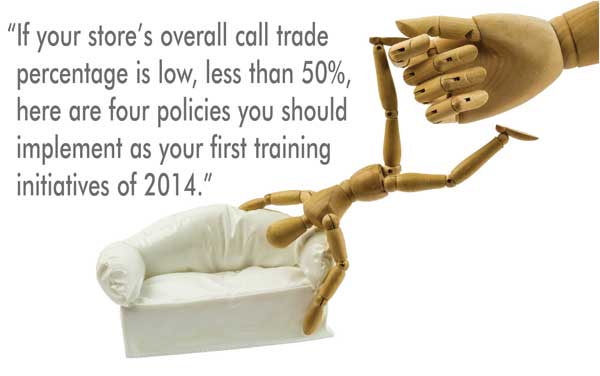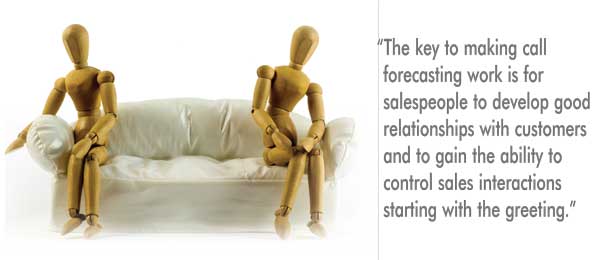Can you validate or provide evidence that your salespeople are professionals, not amateurs?
There are many things high achieving professional salespeople do that set them apart from the majority of retail home sector salespeople. One BIG thing is that they engineer their sales process from the greeting to build call trade, personal trade, referrals and be-backs.
Closing the Magic Gate
What would happen if you told your sales staff on January 1, 2014 that they had just one year to continue to take customer opportunities from the door of your store? After December 31, 2014 a magic gate would close and each salesperson would need to survive only on their own call trade, be-backs and referrals. Would your current sales team survive and thrive or would they starve?
I know one thing for sure; if your sales staff knew that a magic gate would close, cutting off traffic in 365 short days, each salesperson would place a much higher value on each and every customer opportunity entering your store.
What would your sales team do differently with each of these customer opportunities? Do you think your team would easily make the transition from amateur to professional? Or, would most of them continue to be order takers?
You see, there are several huge paradigm shifts that owners must come to grips with in order to attain maximum sales from their available customer traffic opportunities. The first of these shifts is to clearly understand the difference between an amateur and professional, and then take steps to either hire sales professionals or put systems in place to create them.

Amateur Salespeople
Most home sector salespeople are amateurs. Furniture sales is just a job to an amateur. For these folks selling furniture is like visiting a Las Vegas casino where winning and losing sales is a game of chance. They clock in and out, wishing for the best.
The amateur salesperson does just enough to get by, never more than is expected. Customer follow-up is haphazard and reactive. Amateurs are never high achieving salespeople. They are difficult to motivate, often earning 50% less than high achievers on the same sales floor, working the same number of hours.
Professional Furniture Salespeople
Professional salespeople are self motivated and success driven. They leave nothing to chance, placing a high value on each customer opportunity. Professionals control every sales interaction from the greeting all the way through follow-up. These salespeople are proactive and intentional about everything that they do.The result is that they earn a high percentage of call trade, personal trade or be backs.
Nine out of 10 retailers say that their sales teams are made up of professional salespeople. When they are asked to validate or provide evidence to back up that assertion, however, a large majority provide vague, subjective and even judgmental reasons for their belief.
It’s an issue that will be addressed in this and subsequent articles, starting with the story of a professional salesperson named Mack.

CALL TRADE: Mack's True Story
The first way to validate or separate amateurs from their professional coworkers is by measuring call trade. Call trade is simply customers who ask for the salesperson by name. Call trade can be be-backs, repeat customers or even referrals from other customers.
Here is a TRUE story that emphasizes the importance professionals place on call trade. About 30 years ago I asked a high achieving professional salesperson named Mack why he was always way ahead of other salespeople on his floor. He responded, “The secret is, getting your call trade or personal trade to 50% or more in your first 12-months. Saying that is easy. Doing it is difficult. You must make each customer feel as if they are the first and only customer you’ve ever had. You must control the interaction… what I call the silver platter.” Mack went on to say, “The silver platter represents control of the salesperson to customer interaction.” He was absolutely right!
Mack went on to say that he did not want to gamble with his livelihood, so he had found a way to control his customer opportunities even when store traffic was weak.
Here are a few ridiculous scenarios that play out every day in stores nationwide.
How many times have you overheard your sales staff sitting around talking about the potential customers that they WISH would come back and buy. Then at the end of the day, nothing materializes. And, since they neglected to collect customer contact information, they have no real idea if or when these customers may return.
On the other hand, Mack was able to predict with some certainty that a given number of customers would return on a specific day to generate an approximate sales figure. His results were engineered.
Another scenario… Have you ever marked an item down on the floor only to have a salesperson say, “I had a customer interested in that a few days ago.” You say, “Call them.” And you immediately see that salesperson give you a “deer in the headlights” look because no follow-up information was collected for that customer.
In contrast, when Mack saw an item get marked down, he quietly went to his desk and phoned customers who showed an interest in that item within the past month or two. And more than likely, Mack sold it.
Measure Call Trade
The first filter you can use to provide evidence that your sales staff is professional is the percentage of call trade to total traffic. A low call trade percentage means that your staff is simply WISHING that customers will return and has no control over their sales interactions. These amateur salespeople are gobbling up the customer opportunities you provide them and they are doing nothing to boost their call trade. Call trade for these folks is simply an accident and definitely not a planned, proactive and intentional outcome. Low call trade equals low trust, low relationships and usually low sales in trust-based categories such as warranty, protectors etc..
Remember that professional salespeople need professional coaches. As a sales coach, you must coach, review, devise a plan, set the expectations and standards, then coach your sales team. Coaching is made up of four important elements.
- Plan to engineer better call trade numbers.
- Execute in a way that follows the plan.
- Review so you can quantify the results of the plan’s execution.
- Coach your salespeople.
Moving a salesperson from amateur to professional rarely happens by osmosis. Coaches must hold salespeople accountable for results. Coaches who shift accountability without a plan and a way to review results simply create frustrated salespeople.
What To Do If Your Call Trade Is Below 50%
If your store’s overall call trade percentage is low, less than 50%, here are four policies you should implement as your first training initiatives of 2014.
1. Begin capturing customer contact information. Strive to get your percentage of non-buyer customer contact information above 80%.
- Salespeople who are great at disarming customers and building relationships collect high percentages of customer contact information.
- Some salespeople who struggle to obtain contact information are poor at solidifying relationships and building trust. For these salespeople, an interim crutch you might utilize to obtain contact information is a door-prize coupon.
2. Have each salesperson build a Top 30-Prospect list. You will be absolutely amazed at the potential sales volume that is just waiting to be closed.
- Utilize the Top 30-Prospect list as the basis of your monthly private sale events.
3. Add captured customer contact information into a follow-up system. This system must be a well planned, proactive and intentional customer system or program used by each salesperson. Follow up should be choreographed and made preferably by phone rather than by hiding behind email. As the coach it is imperative that you validate that real follow up is happening.
4. Teach your sales staff how to follow up in a professional non-threatening manner. Consider “forecasting” follow up for each and every customer before they leave the store.
What would happen if over the next 90-days your sales staff said the following lines to each and every customer with whom they established a real connection. “Mrs. Customer, I had a blast working with you today. Would you mind if I give you a call in a few days to see how you are progressing on your project?” or “Mrs. Customer, I had a blast working with you today. Would you mind if I give you a call in a few days to see how you are doing on your shopping?”
What will most customers say? They will say Yes. What will most customers think? They will think the salesperson will never call. What a pleasant surprise when the call is made.
A salesperson that gets disconnected at the door a high percentage of the time will have a difficult time making this work. A salesperson that blows qualifying and takes customers on the dreaded product tour will get disconnected a high percentage of the time and also have a hard time making solid connections with customers.
The key to making call forecasting work is for salespeople to develop good relationships with customers and to gain the ability to control sales interactions starting with the greeting.
Next Issue
The next article will discuss how to teach your salespeople to get control of the sales interaction, what Mack called the “Silver Platter.”
Founder of Integrity Business Coaching, Hal McClamma has over 30-years in the home furnishings, appliance and electronics industry. He has owned successful furniture stores and sleep shops. McClamma has been a distribution center manager, single and multiple store manager and company VP for Havertys Furniture, Barrow Furniture, Maas Brothers, Burdines and Jordan Marsh. Contact Hal at Hal@IntegrityBusinessCoaching.com or call 334.470.9999.